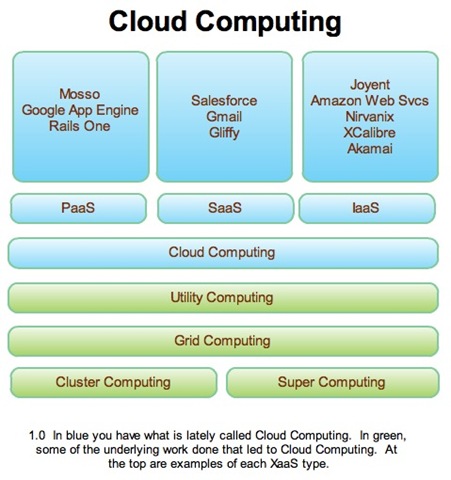Or markets, if you look closely. Simon noted that at his Opscon presentation this year he ended up on the receiving end of an extended diatribe from a gentleman who was arguing determinately that software would never be portable between Amazon EC2 and Google AppEngine (which is probably very true). Simon's response was right on the money:
"I must admit I was somewhat perplexed at why this person ever thought they would and why they were talking to me about it. I explained my view but I also thought that I'd reiterate the same points here.From the ideas of componentisation, the software stack contains three main stable layers of subsystems from the application to the framework to hardware. This entire software stack is shifting from a product to a service based economy (due to commoditisation of IT) and this will eventually lead to numerous competitive utility computing markets based upon open sourced standards at the various layers of this stack.
These markets will depend upon substitutability (which includes portability and interoperability) between providers. For example you might have multiple providers offering services which match the open SDK of Google App Engine or another market with providers matching Eucalyptus. What you won't get is substitutability from one layer of the stack (e.g. the hardware level where EC2 resides) to another (e.g. the framework level where GAE resides). They are totally different things: apples and pears."
I want to take Simon's "stack" theory and refine it further. Look at the layers of the stack, and note that there appears to be a relatively small number of companies in each that can actually drive a large following to their particular set of "standards". In the platform space, of course Google's python-focused (for now) restricted library set is where much of the focus is, but no one has counted out Bungie Labs yet, nor is anyone ignoring what Yahoo might do in this space. Each vendor has their framework (as Simon rightly calls the platform itself), but each has a few followers building tools, extensions, replications and other projects aimed at both benefiting from and extending the benefits of the platform. The diagram below identifies many of the current central players, or "suns", that exist in each technology stack today:

Credit: Kent Langley, ProductionScale
I call these communities of central players and satellites "solar systems" (though perhaps it would be more accurate to call them "nodes and edges", as we will see later).
In each solar system--say the Google AppEngine solar system--you will find an enthusiastic community of followers who thoroughly learn the platform, push its limits, and frequently (though not in every case) find economic and productivity benefits that keep them coming back. Furthermore, the most successful satellite projects will attract their own satellites, and an ever changing environment will form, though the original central players will likely maintain their role for decades (basically until the market is disrupted by an even better technical paradigm).
You already see a very strong Amazon system forming. RightScale, Enomalism and ELASTRA, are all key satellites to AWS's sun. Now you are even starting to hear about satellites of satellites in that space, such as GigaSpace's partnership with RightScale. However, if you look closely at this system, you begin to see the breakdown in the strict interpretation of this analogy, as several of the players (CohesiveFT's ElasticServer On-Demand, for example) starting to address multiple suns in a particular "stack". Thus my earlier comment that perhaps a nodal analogy is somewhat better.
The key here is that for some time from now, technologies created for the cloud will be attached to one or two so-called solar systems in the stack the technology addresses. Slowly standards will start to appear (as one solar system begins to dominate or subsume the others), and eventually the stack will play as a commodity market, though (I would argue) still centered around one key player. By the time this happens, some cross pollination of the stacks themselves will start happen (as has already happened with the prototype of GAE running in EC2), at which point new gaps in standards will be identified. This is going to take probably two decades to play out entirely, at which point the cloud market will probably already face a major disruptive alternative (or "reinvention").
I say this not to be cynical nor to pontificate for pontification's sake. I say this because I believe developers are already starting to choose their "solar system", and thus their technological options are already being dictated by which satellite technologies apply to their chosen sun. Recognizing this as OK, in fact natural to the process, and acknowledging that religious wars between platforms--or at least stacks--is kind of pointless, will make for a better climate to accelerate the consolidation of technical platforms into a small set of commodity markets. Then the real fun begins.
Of course, I'm a big fan of religious wars myself...